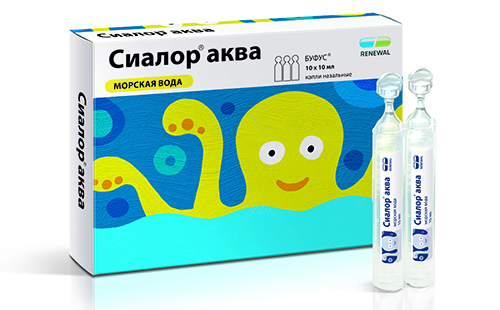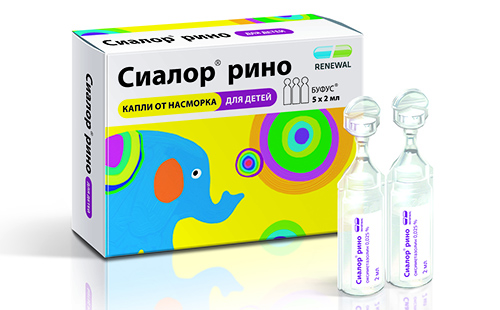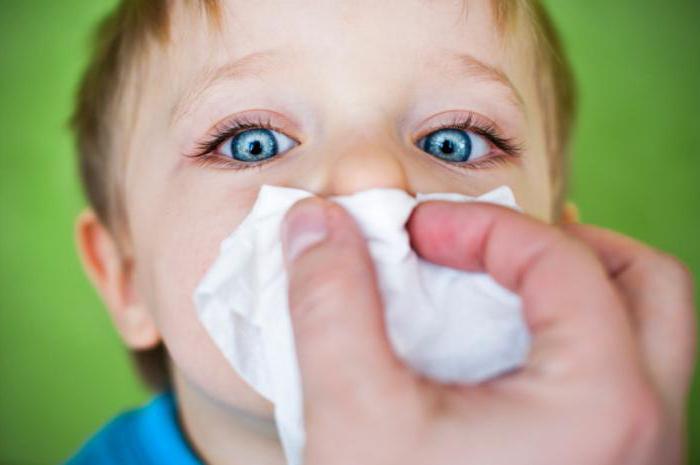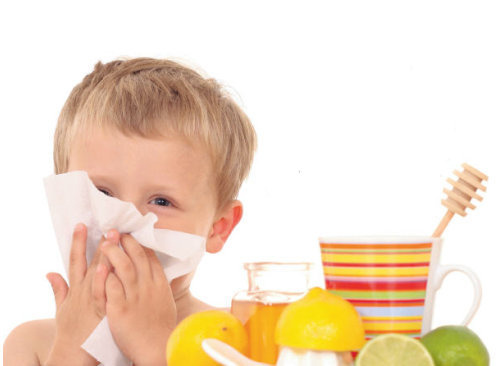A runny nose (rhinitis) is an inflammation of the nasal mucosa. The disease develops as a result of infection with microorganisms (viruses, bacteria, fungi) or exposure to allergens. It is accompanied by symptoms such as sneezing, lacrimation, profuse discharge from the nose of a mucous or purulent nature. A runny nose in a child can run on its own or be one of the manifestations infectious disease: ARVI, flu, scarlet fever, adenovirus infection.
IN childhood the course of rhinitis (inflammation of the nasal mucosa) differs from that in adult patients. In a small child, even seemingly insignificant pathologies of the nasopharynx quickly provoke edema and difficulty in nasal breathing. In children under five years old, this is due to the anatomical and functional features of the upper respiratory tract:
- the nasal passages are shorter and narrower, and the shells are slightly thicker than in adults;
- mechanisms of local immune defense are not formed;
- large looseness of the nasal mucosa;
- sensitivity of the mucous membrane to the slightest external influences;
- insufficient functional activity of the ciliated epithelium;
- insufficiently developed paranasal sinuses.
Restricting the flow of air through the nose causes anxiety in the baby, disrupts his sleep, leads to swallowing air and impaired digestion. In addition, inflammatory changes in the nasal cavity in children are much more likely to cause complications from the ENT organs (sinusitis, bronchitis, pneumonia).
A runny nose in a child lasts longer, more often than in adults, accompanied by edema and the attachment of the pathology of the ENT organs. Strong and lingering runny nose in a child, it can provoke an inflammation of the middle ear, hypertrophy of the nasopharyngeal tonsils, and causes complications from the bronchopulmonary system. This is what worries responsible moms the most.
Causes and clinical symptoms
In most children, a runny nose occurs during a period of sharp fluctuations in air temperatures. It is at this time that the virulence of most pathogens increases, hypothermia of the body is often observed. When cold air enters the upper airways conditionally pathogenic or pathogenic microflora is activated, and viral particles entering from the outside provoke inflammatory reactions in the nasal mucosa. Depending on the causes and pathogenesis, the following types of rhinitis are distinguished:
- infectious (viral, bacterial, mixed);
- allergic;
- caused by taking hormonal or other medications.
Clinically, rhinitis is manifested by nasal congestion, sneezing, the appearance of an inflammatory mucous or purulent discharge. In the case of the addition of inflammation in the middle ear, painful sensations arise from the corresponding side.
If a child has a runny nose for a long time, this may be a sign of adenoiditis and inflammation of the paranasal sinuses. Inflammation of the nasopharyngeal tonsils, in turn, is accompanied by impaired nasal breathing, sore throat and occasional cough due to mucus entering the pharynx.
Features of the treatment of a common cold in a child
Therapy for childhood rhinitis includes several main points:
- cleansing the nasal cavity;
- rinsing the nasal passages;
- the use of anti-congestants, that is, vasoconstrictor drops;
- irrigation or instillation of antibacterial agents.
The choice of treatment method depends on the severity of the manifestations of rhinitis, as well as on its etiology (cause). To treat a runny nose in a child with the help of antibacterial agents should be done only with the bacterial nature of the disease, the presence of purulent discharge from the nose, or complications from the ENT organs.
An obligatory component of the treatment of uncomplicated rhinitis is nasal lavage with preparations based on isotonic solutions. They:
- cleanse the nose safely;
- have anti-inflammatory and antiseptic effects;
- moisturize the mucous membrane and contribute to its faster recovery.
As a rule, rhinitis therapy requires the use of vasoconstrictor drugs. Thanks to them, nasal breathing is restored, which:
- creates comfort for the baby;
- reduces swelling of the nasal mucosa;
- improves mucus drainage.
Treatment of a common cold in a newborn or a young preschool child always includes the use of drugs based on isotonic solutions and often vasoconstrictors. In the modern pharmaceutical market, Sialor Aqua and Sialor Reno are especially noteworthy among such preparations for the common cold for children.
Effective modern means
Sooner or later, absolutely all families face such a phenomenon as a runny nose in a child. And despite the prevalence of the syndrome, the disease always unsettles mothers. Especially the first time. Understanding the responsibility and anxiety parents experience in these moments, modern pharmaceutical manufacturers offer quick and effective remedies for the treatment of this pathology. For example, Sialor Aqua and Sialor Reno are in demand in a children's first aid kit. Such drugs allow not only to carry out effective prevention, but also to quickly cope with the onset of the disease.

"Sialor Aqua"
The greatest success in the treatment of rhinitis is achieved with a combination of isotonic solutions and vasoconstrictor drops. Sialor Aqua belongs to the first category of drugs. Its basis is sea water, which has a rich mineral composition. Sialor Aqua has the following therapeutic effects:
- mechanically removes bacteria and viruses;
- maintains the physiological balance of the nasal mucosa;
- helps to remove discharge from the baby's nose;
- reduces inflammation;
- stimulates the work of the ciliated epithelium of the upper respiratory tract;
- increases the resistance of the mucous membrane to pathogenic microorganisms.
For therapeutic purposes, small children "Sialor Aqua" are instilled two to three drops in each nasal passage three to four times a day. A runny nose in a baby is treated by instilling one or two drops of medicine into the nose.
Sialor Aqua is included in the complex treatment regimen for rhinitis of any etiology: viral, bacterial, allergic. It goes well with vasoconstrictor drops, antibacterial drugs.
The drug is also used to prevent colds in children or simply for hygiene. The use of Sialor Aqua in a polluted environment (dustiness, poor ecology) reduces the incidence of ARVI and increases the resistance of the nasal mucosa. To remove dried crusts or mucus from the nasal passages, it is recommended to bury the agent several times in a row until the discharge softens. After that, the crusts are removed from the nose with a cotton swab.
Sialor Aqua has a convenient buffered form of release (a set of ten plastic containers, each containing 10 ml of the product). It is convenient to take such bufus packages with you on the road.

"Sialor Reno"
"Sialor Rino" refers to vasoconstrictor drugs. Its active ingredient is oxymetazoline hydrochloride. The main property of the drug is a fast and long-lasting effect, which occurs within a couple of minutes, and lasts up to 12 hours. Therefore, only two instillations per day are enough for the baby to feel comfortable.
The main indication for the use of this drug is the elimination of swelling of the nasal mucosa caused by inflammatory or allergic pathologies of the upper respiratory tract. The therapeutic effect after its application is observed within the first minutes after instillation:
- the patency of the nasal passages improves;
- decreased mucus production;
- nasal breathing is restored.
The medicine comes in the form of nasal drops. Recently, large bottles have been replaced by low-dose buffers. This ensures the sterility of the product throughout its shelf life, which is especially important when treating young children. Moreover, a package of five 2 ml buffers is enough for five courses of treatment, which allows you to keep the purchased drug until the next time, and not throw away the unused volume of the drug, as is the case with large bottles.
"Sialor Reno" has a number of advantages over similar products: it is effective for nasal congestion, lasts a long time, is convenient and economical to use.
Rhinitis, despite its seeming harmlessness, can pose a serious danger to a baby. Often it becomes the cause of otitis media, eustachitis, provokes bronchitis or even pneumonia. Therefore, parents should pay attention to any, even minor manifestations of rhinitis and carry out timely treatment of rhinitis in children.
Traditional medicine has a huge number of different recipes for the treatment of rhinitis, including in children of the first year of life. It is important to remember that trusting and blindly following these guidelines is impractical. Many of the methods used for treatment by our grandmothers today are ineffective, and some are even dangerous to health. Also, do not forget about the individual intolerance of the products that make up a particular recipe. The number of allergic diseases has grown significantly since the childhood and adolescence of our parents and grandmothers. Over the years, the number of allergy sufferers has only grown. Therefore, allergy in our time is a very common disease that occurs even to the most unexpected foods.
The choice of the alternative method of treating the common cold must be agreed with the pediatrician!
How to help a child without medication?
Compliance with a number of simple rules will quickly help.
- Constantly cleanse the baby's nose of mucus. To do this, you can use a nasal aspirator (nozzle suction) or a small bulb. Take care not to form crusts. If dried snot is found, it is necessary to carefully remove the crusts from the nasal passages. Before cleaning the nose, the crusts must be softened. To do this, roll up the flagella from cotton wool, wet them in saline and alternately insert them into the nostril for a few minutes. Dried snot will dissolve and come out easily.
- Moisturize the nasal mucosa of a sick child. This requires instilling one drop of saline into each nostril. The solution is prepared simply: a teaspoon of table or sea salt is dissolved in a liter of boiled water.
- Humidify the air in the baby's room. A special humidifier, powered by the mains, will quickly cope with the problem of dry air in the apartment. If it is absent, you can arrange dishes filled with water around the room or hang wet towels and sheets around the room.
- Monitor the baby's drinking regime, more often offer him to drink water. If the child is on breastfeeding, then the nursing mother should drink water more often. This helps to thin the milk.
What runny nose can be treated with folk recipes
Before you start treating a baby, you need to understand the reasons that caused the appearance of snot. A runny nose is a kind of protective reaction that is developed to help the body.
The appearance of snot in a baby may indicate the following changes in his body:
- Physiological rhinitis - transparent snot in small numbers, appearing in the first months of life. Rarely impair respiratory function.
- Snot during teething. Transparent, liquid, often in small quantities. There may be an increase in temperature up to 38.5 degrees.
- Viral infection (ARVI, ARI). The snot is transparent, can be in large quantities. Usually combined with other symptoms: cough, sneezing, fever, weakness.
- Bacterial infection. Snot yellow or green, in large quantities, it is difficult to move away, significantly disturb breathing through the nose.
- Allergic rhinitis.
Traditional medicine can only help with a cold, provoked by an acute respiratory viral infection.
Treat physiological rhinitis or snot during teething is required. This is a normal phenomenon for the baby's body, which quickly passes without intervention.
When bacterial rhinitis folk recipes will not be able to cure a child. In such a situation, the help of a specialist is needed, since the risk of complications is high.
Allergic rhinitis should be treated in conjunction with an allergist, identifying an allergen or allergens that cause a flow from the nose.
Treating a runny nose with breast milk, urine and similar illogical methods is dangerous to the health of the child!
Vegetables will help to quickly cure a runny nose in a baby
Carrot juice is widely used in the treatment of the common cold. To do this, grate a fresh carrot, and then squeeze the juice from the resulting mass through cheesecloth. You need to cook in small quantities, since you cannot store carrot juice. Before instilling the juice, it is necessary to cleanse the nose from excess mucus by instilling saline... For children under six months, carrot juice should be diluted with water 1: 1, older babies can be used undiluted.
Carrot juice acts mildly, as it does not irritate the delicate mucous membrane, relieves puffiness, improves breathing, and helps fight viruses. Carrot juice is usually well tolerated by infants.
The juice of fresh beets is used in the same way.
Onion or garlic juice can help clear your nose and relieve congestion. To do this, you need to prepare onion or garlic water. The juices of these vegetables cannot be used undiluted. Dilute one drop of onion or garlic juice with a tablespoon of water. Instill a drop into each nostril. Such instillation causes sneezing, snot literally flies out of the nose. And phytoncides, found in large quantities in onions or garlic, help fight viral infection.
You can also put the cut halves of these vegetables next to the baby's bed. Older children make "beads" from cloves of garlic. This is an excellent means of preventing colds.
Plants against snot
Many mothers acquire Kalanchoe with the appearance of a child in the house. Indeed, this amazing plant helps to quickly cure the common cold in children and adults. Kalanchoe has a detrimental effect on bacteria, relieves swelling of the mucous membrane, has a healing effect if the mucous membrane is damaged. It is used for severe nasal congestion and snot that is difficult to separate due to its irritating effect.

It is impossible to bury the Kalanchoe juice in its pure form, as you can get a burn of the mucous membrane. The washed leaves must be crushed and squeezed out. Dilute the resulting juice with water in a ratio of 1:10. Bury it drop by drop only with severe congestion and a large number of thick snot.
The second most popular plant that can be found in almost every home is aloe. Aloe juice is prepared according to the same recipe as Kalanchoe. It also needs to be diluted tenfold with water.
Good healing effect has instillation into the nose of decoctions of medicinal herbs: chamomile, calendula, mint, coltsfoot, linden. Herbs are brewed individually or as mixtures. Instill 1-2 drops several times a day in each half of the nose.
To moisturize the nasal mucosa and facilitate breathing, you can drop a drop of sea buckthorn or St. John's wort oil. Large amounts of oil can leak into the respiratory tract, so be careful. It is best to simply lubricate the nasal passages with oil using gauze turunda.
It is strictly forbidden to use undiluted products with a strong irritant effect. These include: onions, garlic, Kalanchoe. They cause a burn of the mucous membrane, which will only complicate the course of the common cold, adding inflammation to it.
Essential oils to fight the common cold
It is forbidden to treat babies with steam inhalation. The steam can cause severe burns to the baby's mucous membranes. But cold inhalations can be used to treat colds and colds. To do this, you need to drop a couple of drops of oil in an aroma lamp or on a regular cotton pad, which should be placed in the children's room. The following essential oils are capable of treating snot: rosemary, orange, mint, pine, eucalyptus, dill, tea tree.

Children prone to allergies to treat folk recipes Absolutely forbidden! Vegetables, plants or oils can cause an allergic reaction, Quincke's edema.
Infant nose massage
Massaging the nose and sinuses is quite simple, and the effect will not keep you waiting. Warm your palms before starting the massage and make sure that the skin on your hands is free from roughness. Otherwise, the baby will be unpleasant, he will start to be capricious, twirl, and a full-fledged massage will not work.
Massage technique:
- Using both hands, stroke from the middle of your forehead to your temples.
- Pat your cheeks in the direction from the temple to the chin.
- Run your finger under the nose, drawing a mustache for the child. First on one side, then on the other.
- Massage pointwise the places located near the wings of the nose and just above the bridge of the nose. The massage is done on both sides.
With regular simple manipulations, the blood supply to the nasal mucosa and sinuses improves. Snot comes off more easily, the risk of inflammatory process sinuses, nasal congestion goes away faster.
If a baby has nasal discharge, do not rush to look for methods and medicines to get rid of this symptom as soon as possible. Do not panic. The first thing to do is call your pediatrician or take your doctor home. Only after the doctor has established the nature of the runny nose, talk to him about the possibility of using folk methods treatment.
Competent treatment of rhinitis in children It usually takes 7-10 days or more to develop a common cold, depending on the type of illness that provoked it. Severe illnesses, such as certain types of acute respiratory viral infections (as well as chronic rhinitis caused by specific infections (syphilis, tuberculosis, gonorrhea) are treated simultaneously with the underlying disease in specialized medical centers. In this article, we will talk about how to properly treat a simple infectious rhinitis in newborns, children of the first years of life and older children It is important that parents caring for sick children have some knowledge of how to properly care for a child with a runny nose and why it is important. How to properly treat a cold in a child? A. First aid In all cases of a cold in a child, before the onset of any drug treatment (that is, treatment with drugs) you need to try to alleviate the child's condition with available means:
- Raise the head of the bed where the baby is lying. To do this, a pillow can be placed under the child's shoulders, so that the child's head and upper body are located at an angle of 40-45 to the body. (make sure the child is comfortable in this position). This will make the phlegm in your nose easier to pass and you may not need to use any medication.
- If a newborn or infant has a very stuffy nose with phlegm, you can try to suck mucus from the nasal passages with a rubber bulb or a regular syringe. In general, phlegm suction is used to help children who cannot blow their nose on their own. To suction sputum, you can use an ordinary rubber bulb with a fairly thin tip or an ordinary syringe without a needle. It is necessary to carefully insert the tip of a pear or syringe into the nasal passage of a child with a runny nose, so as not to injure the mucous membrane. The mucus is sucked out first from one and then from the other nasal passage. This procedure can be repeated as often as necessary.
|
